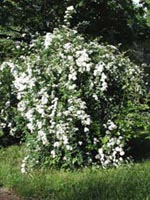Resource Library
Plant of the Week: Vanhoutte Spirea
The University of Arkansas System Division of Agriculture does not promote, support or recommend plants featured in "Plant of the Week." Please consult your local Extension office for plants suitable for your region.
Plant of the Week
Vanhoutte Spirea
Latin: Spiraea x vanhouttei

The nursery business is an intriguing area of study because it brings together people with conflicting passions - those whose first love is plants with those whose first love is money. The tension created by this dichotomy seems to have always existed, but the scale of modern business has magnified these differences like never before. Let us follow a plant, in this case the old-fashioned Vanhoutte Spirea (Spiraea vanhouttei), from its introduction in 1862 to modern times and see how the plant marketplace has changed.
Vanhoutte spirea is arguably the best spirea ever introduced. If not the best, it has been propagated in larger numbers than most others of its ilk. Vanhoutte spirea’s modest 6-foot height, 8-foot spread and fountain-shaped form make it well suited for the average landscape. The white, quarter inch wide flowers are borne in 2-inch wide flat-topped umbels that line the arching stems producing a dependable display every spring.
The foliage, while deciduous, has a distinctive blue-green color. It's hardiness to cold (zones 3-8) and indifference to environmental stress made it one of the ironclad plants that persist in our landscapes regardless of the attentiveness of the gardener.
In 1862 a nurseryman named Billiard, who worked at Fontenary aux Roses near Paris, released his hybrid progeny to the world. But, as often happens, it was the Belgian nurseryman Louis Van Houtte (1810 - 1876) who popularized the plant and had it named in his honor.
The arrival of Vanhoutte spirea to the United States is uncertain but the 1888 Burpee catalog gives it a half page and says of it: "This rare variety is the most showy of all the Spireas, and one of the very best shrubs in cultivation."
At the time the American nursery industry was primarily centered in the Great Lakes region and mainly focused on growing fruit trees. Larger cities had retail nurseries, but they were few and far between. During this period the American populace was as widely dispersed across the land as it would ever become. The Jeffersonian ideal of a nation of small, independent farmers all working there quarter section of land was firmly established.
To service this market, traveling peddlers crisscrossed the land with their detail books showing any who would listen the plants they had for sale. Sales were made in the summer and fall for delivery the following spring.
The inefficiency of this marketing system was quickly discovered so, as the 20th century dawned, mailorder houses began to expand with peddlers disappearing shortly after WWI. Of course the giant mailorder houses -- Sears & Roebuck, Montgomery Ward & Co. and J. C. Penny -- sold all sorts of items and they threatened the local retail merchants. Dee Brown, the late Little Rock author, described in his memoir When the Century was Young how local merchants would pay a $1 bounty for any Sears catalogs turned in so they could have a book burning party in the main street of Stevens where he grew up.
The mail order houses also sold plants. A 1932 nursery catalog from Montgomery Ward & Co. advertises "Popular varieties at the lowest prices in history." They offer a dozen 18- to 24-inch Vanhoutte spireas for 45 cents. But this too was to fade because consumers wanted instant gratification. They wanted to see and touch the plants they were buying.
After WWII the modern garden center movement took root and spread across the nation. As the highway system improved, plants grown in distant locations could be sold in any quarter of the country.
But this marketing strategy was quickly challenged by the new kid on the block, the mass market stores such as Wal-Mart. The first Wal-Mart store manager, Bob Bogle, has always had a keen interest in plants and told me he sold plants out of the Ben Franklin store he managed for Sam Walton in the late 1950's.
Even the primacy of this retail giant is not secure, at least as it relates to plants, because new retail giants - the category killers such as Lowe's and Home Depot - offer a wider assortment than a general merchant can. In Texas, and probably most markets, 80 percent of retail plant sales are through the big box stores. To compete the independent garden centers have had to get larger or focus more on landscape work or maintenance services.
Through it all, the Vanhoutte spirea lingers on the fringes of popularity. Most retailers still have a few plants for sale each spring. In the garden, give Vanhoutte spirea full sun and room to spread, and it will take care of the rest.
By: Gerald Klingaman, retired
Extension Horticulturist - Ornamentals
Extension News - March 7, 2003
The University of Arkansas System Division of Agriculture does not maintain lists of retail outlets where these plants can be purchased. Please check your local nursery or other retail outlets to ask about the availability of these plants for your growing area.